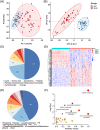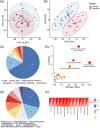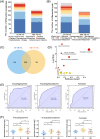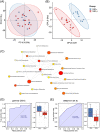Serum Metabolomics Analysis of Skin-Involved Systemic Lupus Erythematosus: Association of Anti-SSA Antibodies with Photosensitivity
- PMID: 37667802
- PMCID: PMC10475307
- DOI: 10.2147/JIR.S426337
Serum Metabolomics Analysis of Skin-Involved Systemic Lupus Erythematosus: Association of Anti-SSA Antibodies with Photosensitivity
Abstract
Purpose: Systemic lupus erythematosus is a heterogeneous autoimmune disease in which skin involvement is a common manifestation. It is currently thought that the photosensitivity of SLE skin involvement is associated with anti-SSA antibodies. This study aimed to expand the current state of knowledge surrounding the molecular pathophysiology of SLE skin photosensitivity through Serum metabolomics analysis.
Patients and methods: The serum metabolites of 23 cases of skin-involved SLE (SI) group, 14 cases of no SI (NSI) group, and 30 cases of healthy controls (HC) were analyzed by using UPLC-MS/MS technology, and subgroup analysis was performed according to the expression of anti-SSA antibodies in SI. MetaboAnalyst 5.0 was used for enrichment analysis and ROC curve construction, identifying serum metabolic markers of skin-involved SLE associated with anti-SSA antibodies.
Results: We identified several metabolites and metabolic pathways associated with SLE photosensitivity. Two metabolites, SM (d18:1/24:0) and gamma-CEHC can distinguish between anti-SSA antibody-positive and negative SI, with AUC of 0.829 and 0.806. These two photosensitization-related substances may be potential markers of skin involvement in SLE associated with anti-SSA antibody.
Conclusion: This study provides new insights into the pathogenesis of SI patients, and provides a new molecular biological basis for the association between anti-SSA antibodies and skin photoallergic manifestations of SLE.
Keywords: anti-SSA antibodies; biomarkers; metabolomics; photosensitivity; systemic lupus erythematosus.
© 2023 Lu et al.
Conflict of interest statement
The authors report no conflicts of interest in this work.
Figures





Similar articles
-
Anti-RO/SSA and anti-La/SSB antibodies: Association with mild lupus manifestations in 645 childhood-onset systemic lupus erythematosus.Autoimmun Rev. 2017 Feb;16(2):132-135. doi: 10.1016/j.autrev.2016.12.004. Epub 2016 Dec 14. Autoimmun Rev. 2017. PMID: 27988434 Review.
-
Two subgroups in systemic lupus erythematosus with features of antiphospholipid or Sjögren's syndrome differ in molecular signatures and treatment perspectives.Arthritis Res Ther. 2019 Feb 18;21(1):62. doi: 10.1186/s13075-019-1836-8. Arthritis Res Ther. 2019. PMID: 30777133 Free PMC article.
-
Chilblain lupus erythematosus is associated with antibodies to SSA/Ro.Adv Exp Med Biol. 1999;455:167-71. doi: 10.1007/978-1-4615-4857-7_24. Adv Exp Med Biol. 1999. PMID: 10599339
-
Photosensitivity in systemic lupus erythematosus: laboratory testing of ARA/ACR definition.Lupus. 1996 Aug;5(4):263-8. doi: 10.1177/096120339600500404. Lupus. 1996. PMID: 8869896
-
Serology of Lupus Erythematosus: Correlation between Immunopathological Features and Clinical Aspects.Autoimmune Dis. 2014;2014:321359. doi: 10.1155/2014/321359. Epub 2014 Feb 6. Autoimmune Dis. 2014. PMID: 24649358 Free PMC article. Review.
Cited by
-
Relationship between clinical manifestations and serological profile in patients affected by Systemic Lupus Erythematosus.Front Immunol. 2024 Aug 16;15:1390642. doi: 10.3389/fimmu.2024.1390642. eCollection 2024. Front Immunol. 2024. PMID: 39221240 Free PMC article.
References
LinkOut - more resources
Full Text Sources
Research Materials

